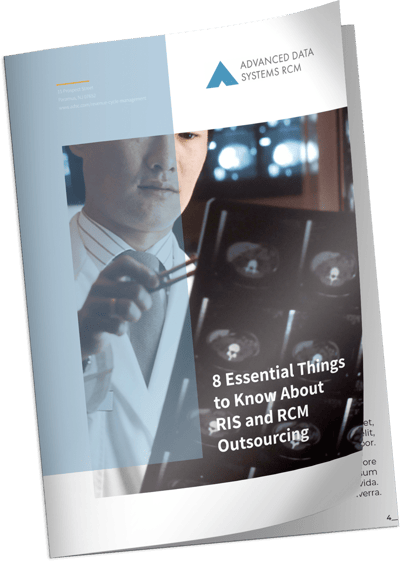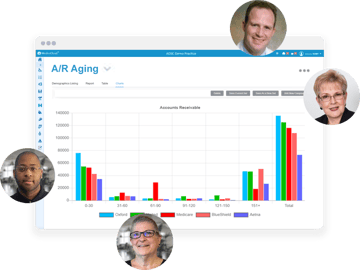Diagnostic and interventional imaging centers, enterprise radiology networks, and rural/critical access hospital radiology departments need to drive maximized revenue cycle management.
This is especially true considering how staffing issues are impacting radiology and healthcare in general making patient care more difficult.
With those thoughts in mind, we present our eight RCM RISsentials.

 Getting paid can’t be overlooked as an RCM RIS essential. Yet “getting paid” isn’t even enough. You need to derive maximum value reimbursements for your claims with an almost 100% success rate on first-attempt clearinghouse submissions for HCFA, UB, workers' compensation, and no-fault claims.
Getting paid can’t be overlooked as an RCM RIS essential. Yet “getting paid” isn’t even enough. You need to derive maximum value reimbursements for your claims with an almost 100% success rate on first-attempt clearinghouse submissions for HCFA, UB, workers' compensation, and no-fault claims.
But even before a radiology claim is submitted at its maximized value, you must have multiple ways to ensure being paid. For proper revenue management, your outsourced Radiology revenue cycle management team and the platform they use – and to which you should also have transparent, on-demand access – must support:
*Prior Authorizations: According to a January 2020 report by Fierce Healthcare, providers spend an average of almost $11.00 per transaction to conduct manual PAs vs. an average of $1.88 electronically, and the overall 2019 calendar year increased the spend on PAs by 60% over CY 2018. The dollar cost to manually obtain PAs doesn’t include the excessive, tedious staff time required to get them.
When the Radiology RCM service and RIS support features such as these, the imaging center or network can be assured of maximized revenue through minimized in-house staffing efforts. The combination of increased insurance and patient revenue along with compressed staffing makes for a dramatically significant bottom-line improvement. Well-managed RCM services will reduce claim denials, costly errors, and improve the patient experience.
 Staffing issues have been plaguing the entire employment arena, obviously including healthcare. So, in addition to ensuring you obtain maximized revenue as mentioned, you need to deal with that.
Staffing issues have been plaguing the entire employment arena, obviously including healthcare. So, in addition to ensuring you obtain maximized revenue as mentioned, you need to deal with that.
But here’s a thought: staffing issues could actually be great for you!
Consider in-house staffing costs. Recruiting, hiring, salaries, raises, benefits, administration, HR issues, workspace, equipment. And those are just the generic items for all employees.
You have more: medical billing, claims, patient statements, patients calling with statement questions, EOB reconciliations, generating reports, and dealing with patients’ attorneys on injury cases. You can probably think of a lot more based on your own setup. And of course, there are all of the items mentioned above in #1.
If you could consolidate staffing and not miss a beat, then yes, perhaps it would be good to have staffing issues.
At a time when every dollar counts, and when optimized efficiency has never been more important, it may also be the ideal time for you to consider an outsourced RCM company that has a behind-the-scenes workforce to help consolidate your in-house staffing issues.
 Is it really possible to do all three? Yes, if you’re with an RCM company and a RIS that supports them.
Is it really possible to do all three? Yes, if you’re with an RCM company and a RIS that supports them.
Of course, providing a referring physician portal is another key to keeping them connected and referring.
These are all RCM RIS essentials, and MedicsRCM/MedicsRIS support everything as described.
 You’re in radiology which means you no doubt have personal injury patients, which in turn means they no doubt have attorneys, which then means you need to track those attorneys and spend inordinate amounts of time with their requests for files, letters, images, etc. for their clients (your patients).
You’re in radiology which means you no doubt have personal injury patients, which in turn means they no doubt have attorneys, which then means you need to track those attorneys and spend inordinate amounts of time with their requests for files, letters, images, etc. for their clients (your patients).
it’s a lot of turns which is appropriate because patients’ attorneys can have your staff running in circles. And, you basically get nothing for accommodating attorney requests.
You need two things: (1) a built-in RIS attorney management database with all of their information, and with their profiles attached to each corresponding client (your patients) in a case-specific format since one patient could have multiple attorneys for multiple cases, and (2) a self-serve attorney portal option enabling them or their staff to retrieve whatever they need on demand without disrupting your staff.
Yes, these attorney-related capabilities would make life so much easier for you. That’s why we see attorney management as being an absolute RCM RIS essential and that’s why MedicsRCM and MedicsRIS support attorney management and a self-serve attorney portal.
 Radiology operates in a very competitive industry and in competitive industries, marketing and advertising are not unusual.
Radiology operates in a very competitive industry and in competitive industries, marketing and advertising are not unusual.
Yes, we mentioned most patients probably come by way of referring physicians. Still, marketing and advertising may well be - or perhaps should be - part of your overall operation. If you agree or are actually engaged in marketing/advertising, you’ll need a customer relationship manager (CRM) to track the effectiveness of those campaigns and help manage the marketing aspects of revenue cycle management.
CRMs can be expensive; a six-figure price tag isn’t unusual based on features and system size. An alternative would be a RIS with a built-in, no extra cost CRM section.
MedicsRCM and MedicsRIS support CRM functionality. And if you have an existing CRM or prefer to use a different CRM, that’s fine. We’ve interfaced with virtually every major CRM including Salesforce, Sugar, Zoho, and more.
 You have radiologists, technicians, and expensive diagnostic equipment. All three need to operate and produce revenue as efficiently as possible, not idling unproductively either because of gaps or bottlenecks. Good revenue cycle management outsourcing is one way you can ensure the revenue that is billed is also collected.
You have radiologists, technicians, and expensive diagnostic equipment. All three need to operate and produce revenue as efficiently as possible, not idling unproductively either because of gaps or bottlenecks. Good revenue cycle management outsourcing is one way you can ensure the revenue that is billed is also collected.
Furthermore, a few things are needed to help ensure your imaging center is humming at maximum efficiency.
You’ll want a multi-modality scheduler for your medical practice that doubles as a powerful workflow manager to keep things moving along without hiccups, a built-in mammography tracking component and interactive appointment reminder texting to ensure costly no-shows are eliminated to the greatest extent possible.
MedicsRCM and MedicsRIS support radiology scheduling and workflow as described, and with features also as described making revenue cycle management a breeze for healthcare organizations.
 Your reports might be complicated, but producing them shouldn’t be. You shouldn’t need a team of people dedicated to compiling your KPIs, analytics, and dashboards as MGMA recently reported many groups have required.
Your reports might be complicated, but producing them shouldn’t be. You shouldn’t need a team of people dedicated to compiling your KPIs, analytics, and dashboards as MGMA recently reported many groups have required.
A knowledgeable team of financial and operational analysts as part of a Radiology Revenue Cycle Mangement service that uses an AI-architected, rules engine-driven RIS platform supporting monthly closes and predictive analytics, should routinely compile the data you need, and review it with you on a regular basis to ensure overall financial health.
That said, you should also be able to create any reports at any time, to the extent you want by having 100% transparent access to your data. Even more, you should be able to save reports and have them compile automatically at specified days/times with exportability to Excel®.
You simply can’t guess how things are going. You need the data to confirm it. You want to know areas of strength and weaknesses, and how they can be improved through actionable intel, including predictive analytics on how things appear to be headed.
The RCM service and RIS must be able to provide financial and operational insights. For that reason, analytics is an RCM/RIS essential. MedicsRCM and MedicsRIS support comprehensive analytics as mentioned.
 Your data is your data. It doesn’t belong to the RCM company. For that reason, you must have 100% transparent, on-demand access to all of your data. Nothing should be hidden or curtained.
Your data is your data. It doesn’t belong to the RCM company. For that reason, you must have 100% transparent, on-demand access to all of your data. Nothing should be hidden or curtained.
With that type of transparency, you would always be able to see how things are going, and how the RCM company is doing. Essentially, you’d see what they see.
So for example, the RCM company should handle denials (as mentioned in #1 above) and claim tracking in real-time to see how your claims are progressing. But you might want to see denials as well. The RCM company is no doubt handling EOB reconciliations, but you might also want to see your EOBs.
The same is true for insurance and patient A/R, provider productivity, procedures performed, revenue generated by the payer, and more in the healthcare industry. Hundreds and hundreds of different types of analytics should be viewable by you, to the extent you want to view them in addition to those reviewed with you by the RCM team.
As mentioned in #7 above, you should be able to create any report at any time, to the extent you want.
If the outsourcing revenue cycle management is performing well based on cash flow and KPIs, you should be encouraged to see how things are going. If they’re not performing well, they’d probably not want you to see how things are going.
MedicsRCM supports total, 100% transparency to all of your data, on-demand, 24 x 7 x 365. It’s why we train clients on using MedicsRIS. We encourage clients to connect and view whatever they want, whenever they want.
Radiology practices need to rely as fully and completely as possible on automated systems for EDI, scheduling, reports, ways to keep the waiting room filled, tools for complying with CMS requirements, and so much more.
A good revenue cycle management company and RIS may do some of this. A great RCM and RIS can do it all and more, including:
And the RIS should be available if an in-house platform is preferred. MedicsRCM supports everything mentioned above, and if preferred, the MedicsRIS platform from ADS can be implemented on its own. If you have any questions about outsourcing revenue cycle management, book a meeting with an ADS RCM advisor.
Click the button below to schedule a time to speak with a member of our team.